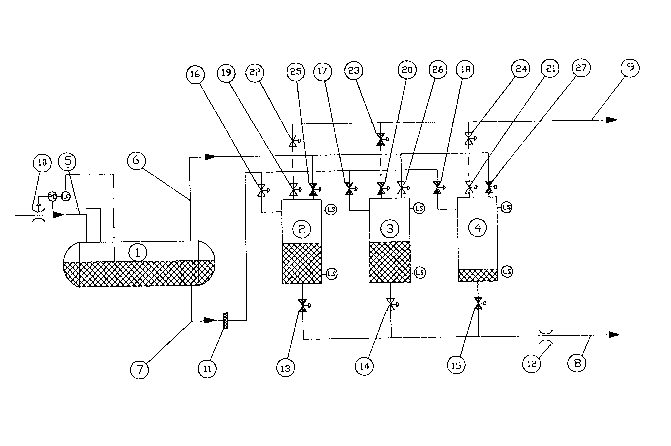Une partie des informations de ce site Web a été fournie par des sources externes. Le gouvernement du Canada n'assume aucune responsabilité concernant la précision, l'actualité ou la fiabilité des informations fournies par les sources externes. Les utilisateurs qui désirent employer cette information devraient consulter directement la source des informations. Le contenu fourni par les sources externes n'est pas assujetti aux exigences sur les langues officielles, la protection des renseignements personnels et l'accessibilité.
L'apparition de différences dans le texte et l'image des Revendications et de l'Abrégé dépend du moment auquel le document est publié. Les textes des Revendications et de l'Abrégé sont affichés :
| (12) Brevet: | (11) CA 1314303 |
|---|---|
| (21) Numéro de la demande: | 1314303 |
| (54) Titre français: | METHODE DE SEPARATION GAZ-LIQUIDE |
| (54) Titre anglais: | METHOD FOR SEPARATING GAS AND LIQUID |
| Statut: | Périmé et au-delà du délai pour l’annulation |
| (51) Classification internationale des brevets (CIB): |
|
|---|---|
| (72) Inventeurs : |
|
| (73) Titulaires : |
|
| (71) Demandeurs : |
|
| (74) Agent: | G. RONALD BELL & ASSOCIATES |
| (74) Co-agent: | |
| (45) Délivré: | 1993-03-09 |
| (22) Date de dépôt: | 1989-09-28 |
| Licence disponible: | S.O. |
| Cédé au domaine public: | S.O. |
| (25) Langue des documents déposés: | Anglais |
| Traité de coopération en matière de brevets (PCT): | Non |
|---|
| (30) Données de priorité de la demande: | |||||||||
|---|---|---|---|---|---|---|---|---|---|
|
- 6 -
ABSTRACT: A method for the transportation and separation of
gas from liquid and solid media in one or several
stages in a manner so that the pressure in the
gaseous phase from an early separator stage or
from another gas deposit is utilized for the
transportation of the fluids produced in sub-
sequent separator stages. Gas which is separated
off at high pressure in an early separator stage
or gas from another gas deposit is led into a se-
parator which has carried out separation at a
lower pressure. The high pressure gas forces out
the ready separated fluid which is present in the
separator receiving the high pressure gas. The
separator stage which receives high pressure gas
from a preceding stage or another gas source, is
made up of several identical separators which al-
ternate in carrying out the functional phases
stated below in the sequence indicated so that
there is at all times one separator carrying out
functions within one phase.
Phase 1 Gas is separated from liquid at a pres-
sure necessary to maintain export of gas
from the process.
Phase 2 Liquid is exported out of the separator
by means of gas from a preceding separa-
tor stage or from another gas deposit.
Phase 3 The separator is decompressed by gas be-
ing let out of the separator to a gas
export line.
Note : Les revendications sont présentées dans la langue officielle dans laquelle elles ont été soumises.
Note : Les descriptions sont présentées dans la langue officielle dans laquelle elles ont été soumises.

2024-08-01 : Dans le cadre de la transition vers les Brevets de nouvelle génération (BNG), la base de données sur les brevets canadiens (BDBC) contient désormais un Historique d'événement plus détaillé, qui reproduit le Journal des événements de notre nouvelle solution interne.
Veuillez noter que les événements débutant par « Inactive : » se réfèrent à des événements qui ne sont plus utilisés dans notre nouvelle solution interne.
Pour une meilleure compréhension de l'état de la demande ou brevet qui figure sur cette page, la rubrique Mise en garde , et les descriptions de Brevet , Historique d'événement , Taxes périodiques et Historique des paiements devraient être consultées.
| Description | Date |
|---|---|
| Inactive : CIB de MCD | 2006-03-11 |
| Inactive : CIB de MCD | 2006-03-11 |
| Le délai pour l'annulation est expiré | 2003-03-10 |
| Lettre envoyée | 2002-03-11 |
| Accordé par délivrance | 1993-03-09 |
Il n'y a pas d'historique d'abandonnement
| Type de taxes | Anniversaire | Échéance | Date payée |
|---|---|---|---|
| TM (catégorie 1, 5e anniv.) - générale | 1998-03-09 | 1998-02-23 | |
| TM (catégorie 1, 6e anniv.) - générale | 1999-03-09 | 1999-02-24 | |
| TM (catégorie 1, 7e anniv.) - générale | 2000-03-09 | 2000-02-24 | |
| TM (catégorie 1, 8e anniv.) - générale | 2001-03-09 | 2001-02-27 |
Les titulaires actuels et antérieures au dossier sont affichés en ordre alphabétique.
| Titulaires actuels au dossier |
|---|
| AKER ENGINEERING A.S |
| Titulaires antérieures au dossier |
|---|
| KRISTIAN BREKKE |